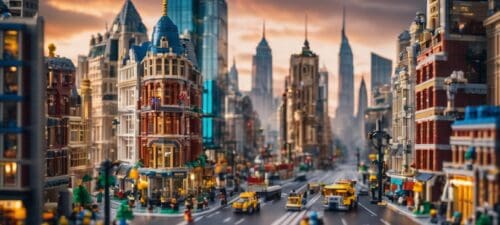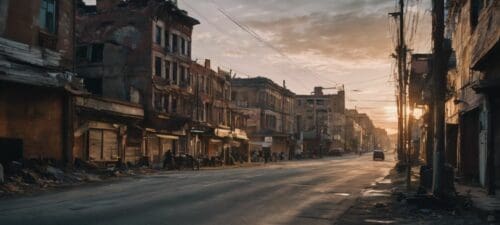Cities: Skylines: The Art of Urban Planning

Updated On: October 25, 2025 by 
Creating the quintessential city is no small feat—it’s a task that can confound even the most fervent urban planners among us. We’ve all experienced the vexing challenge of trying to ensure our residents are chirpy while keeping our buses and trains running on time.
But there’s good news: we’ve delved into the intricacies of Cities: Skylines, a game celebrated for its realistic portrayal of urban development. In this piece, we will steer you through navigating municipal mazes—from deciphering zoning conundrums to untangling congested roads.
Prepare to delve into the artistry of crafting thriving metropolises!
The Use of Cities: Skylines in Urban Planning
Cities: Skylines stands out as a simulation game that allows players to tackle the complex challenges of urban planning and design. Its realistic approach provides valuable insights into the intricacies of managing a city, making it a useful tool for understanding the dynamics of urban development.
Compared to other simulation games
As we delve into the world of virtual urban development, it’s fascinating to compare Cities: Skylines to its peers in the simulation game genre. The unique features of Cities: Skylines help it stand out as a more specialised tool for urban planning enthusiasts. Here’s a concise comparison:
| Aspect | Cities: Skylines | Other Simulation Games |
|---|---|---|
| Focus | Emphasises comprehensive urban planning and transportation systems. | May concentrate on broader simulation aspects, including individual building design, people management or economic scenarios. |
| Realism | Offers a realistic approach to city building, considering various urban development aspects. | Can be less focused on realism, offering a more abstract or simplified city-building experience. |
| Planning Tools | Provides detailed tools for laying out roads, zoning, and public services. | Tools may be less detailed, focusing on simplified construction and management. |
| Educational Value | Used by urban planners to model and test real-world planning ideas, offering insights into urban design. | Often designed more for entertainment, with less focus on real-world applicability. |
| Modding Community | Has an active modding community that creates additional content and tools to simulate urban environments accurately. | Modding communities may not be as focused on creating tools for accuracy in urban simulations. |
| Engagement with Urban Issues | Tackles issues like transportation, noise pollution, and the cyclical nature of cities. | May not address urban issues as thoroughly, aiming more for general gameplay satisfaction. |
Through this table, we’ve highlighted key differences that make Cities: Skylines a valuable and engaging platform for players to understand the intricacies of urban planning. It provides a deeper, more nuanced experience for those interested in the art and challenges of designing a city.
Advantages and limitations
Cities: Skylines offers a realistic and in-depth city-building experience with its top-down layout planning. It allows players to explore and experiment with various aspects of urban development, providing hands-on experience in urban planning concepts and challenges.
- Advantages:
- Enables players to test and showcase planning ideas in a virtual environment.
- Encourages consideration of multiple aspects of urban development such as transportation and noise pollution.
- Offers an interactive method for learning about urban planning compared to traditional theoretical methods.
- Limitations:
- Focuses on top – down layout planning rather than individual building design.
- May not provide the same level of detail as some other simulation games in terms of individual building customisation.
- While it encourages exploration, it may not fully capture the complexities of real – world urban planning scenarios.
Lessons from Playing Cities: Skylines
In playing Cities: Skylines, we can learn the importance of walkability and how it impacts urban design. The game also highlights the significant role transit plays in city planning and the cyclical nature of cities as they grow and evolve.
Importance of walkability
Walkability is a crucial aspect of urban planning that Cities: Skylines highlights. It emphasises the need for cities to be pedestrian-friendly, promoting accessibility and encouraging physical activity.
This feature allows players to understand how walkable neighbourhoods contribute to a healthier urban environment while improving the overall quality of life for residents. By experiencing the impact of walkability in the game, both experts and novices can comprehend its significance in creating sustainable and vibrant communities.
Cities: Skylines encourages an awareness of pedestrian infrastructure through virtual experience, showcasing the importance of well-designed pavements, safe crossings, and connected pathways.
The impact of highways on urban design
After understanding the importance of walkability in urban planning, it’s vital to consider the impact of highways on urban design. Highways play a significant role in shaping city layouts and traffic flow.
Their placement affects accessibility, noise pollution, and community division. With increasing population growth and urban expansion, cities face challenges in balancing highway development with sustainable design and environmental impact.
Considering the environmental impact of highways is crucial as they can contribute to air and noise pollution. City planners must also address concerns related to sustainable design when integrating highways into urban landscapes while ensuring that they do not hinder overall city infrastructure development.
The role of transit
We discovered that the impact of highways on urban design is vast, influencing traffic flow and city layout. Another crucial piece in the urban planning puzzle is the role of transit.
Cities: Skylines introduces players to the importance of efficient public transportation systems for sustainable urban development. Through this game, individuals learn about the significance of well-connected transit networks in reducing traffic congestion, improving air quality, and promoting equitable access to different parts of the city.
Moreover, players gain insights into designing comprehensive transit routes that cater to diverse commuter needs while minimising environmental impact. This interactive learning opportunity allows both novices and experts to grasp the complexities involved in creating an effective public transport system within a bustling metropolis.
The significance of neighborhood design
Neighborhood design in Cities: Skylines is crucial for creating a functional and aesthetically pleasing urban environment. We consider factors such as walkability, green spaces, and mixed land use to ensure that neighborhoods are vibrant and livable.
Players learn the importance of placing essential amenities within easy reach while also balancing residential, commercial, and recreational areas to foster a sense of community.
Cities: Skylines allows us to experiment with different neighborhood designs to understand their impact on traffic flow, public transportation accessibility, and overall quality of life for residents.
The cyclical nature of cities
Transitioning from the significance of neighborhood design, we delve into the cyclical nature of cities. Cities are dynamic entities with ever-evolving needs and demands. The growth and decline of urban areas follow a cycle influenced by economic, social, and technological changes.
As cities expand and evolve, so do their infrastructural requirements to meet the needs of their inhabitants.
City development is impacted by various factors such as population growth, economic shifts, technological advancements, and environmental considerations. These elements contribute to the ebb and flow of urban landscapes as they adapt to changing circumstances.
The Influence of Jobs and Arts on Urban Planning
Balancing economic growth and quality of life is crucial in urban planning. Incorporating the arts into city design can lead to vibrant, culturally rich communities that enhance the overall quality of life for residents.
Balancing economic growth and quality of life
Balancing economic growth and quality of life is a pivotal aspect of urban planning in Cities: Skylines. Players must strive to foster a thriving economy while also ensuring the well-being of their virtual citizens.
This entails creating job opportunities, fostering business growth, and maintaining a healthy balance between commercial and residential zones. In doing so, players learn the intricate relationship between economic prosperity and community welfare within the game’s virtual environment.
The game prompts users to consider how factors such as employment opportunities, education access, healthcare facilities, and recreational areas contribute to an enhanced quality of life for city residents.
Incorporating the arts into urban design
In urban design, incorporating the arts adds a vibrant and cultural dimension to city spaces. Public art installations, street murals, and sculptures can transform urban landscapes into visually stimulating environments that reflect the community’s identity and history.
By integrating art into public spaces, cities can promote civic engagement and create inclusive environments that bring people together.
Public art also contributes to economic development by attracting tourists and supporting local artists. It enhances the aesthetic appeal of neighborhoods and encourages pedestrian activity.
Moreover, artistic elements can serve as focal points for social interaction and community gatherings, enriching the overall quality of life in metropolitan areas.
The Role of First Responders in City Planning
Considering the safety and accessibility of all citizens, first responders play a crucial role in urban planning. It’s important to factor in emergency response times and access for police, fire, and medical services when designing cities.
Ensuring safety and accessibility for all
- Designing well – connected road networks to facilitate efficient emergency response and access to key services.
- Implementing accessible public transportation systems to cater to the needs of all citizens, including those with disabilities.
- Introducing green spaces and pedestrian – friendly pathways to enhance community safety and promote walkability.
- Integrating mixed – use development to create vibrant, inclusive neighbourhoods that cater to diverse populations.
- Providing adequate infrastructure for first responders, such as fire stations and medical facilities, strategically placed across the city.
Considering emergency response in urban design
When designing urban areas, it is crucial to consider the effectiveness of emergency response. Cities: Skylines offers valuable lessons on integrating emergency services into urban planning:
- Ensuring Safety and Accessibility for All: Urban planning should prioritise creating accessible routes for emergency vehicles to reach all areas of a city swiftly.
- Accounting for Emergency Response in Urban Design: Planning must include provisions for fire stations, police stations, and hospitals strategically located throughout the city.
- Balancing Economic Growth with Emergency Preparedness: Incorporating emergency response facilities while maintaining a balance between economic development and public safety is essential.
- Integrating Disaster Management Strategies: Implementing disaster management systems and evacuation routes can mitigate the impact of emergencies on metropolitan areas.
- Utilising Modern Technologies for Emergency Situations: Urban planning should integrate advanced technologies to improve communication between first responders during emergencies.
- Safeguarding Against Potential Hazards: Assessing potential hazards such as chemical plants or flood-prone areas and adjusting city planning accordingly is critical to ensuring public safety.
- Engaging Citizens in Emergency Preparedness: Educating citizens about emergency response protocols and involving them in community-based preparedness efforts is an integral part of urban design.
Final Thoughts and the Search for Truth in Urban Planning
In the game “Cities: Skylines,” players can explore urban planning concepts and challenges by virtually designing and managing cities. The game offers a practical and interactive method for learning about the complexities of urban development.
Through gameplay, individuals can experiment with city design, transportation systems, noise pollution, and neighborhood layouts. It provides valuable insights into the cyclical nature of cities and encourages players to consider various aspects of urban planning in a hands-on environment.
With its focus on top-down layout planning, “Cities: Skylines” is an engaging tool that appeals to those interested in city-building and urban management games.
Conclusion
In conclusion, Cities: Skylines offers a unique and immersive experience to explore urban planning concepts. The game provides valuable insights into the complexities of city design and management.
It serves as an interactive tool for learning about urban development, making it an invaluable resource for both gamers and urban planning enthusiasts. With its focus on top-down layout planning and realistic city-building, Cities: Skylines presents a compelling platform to understand the art of urban planning in an engaging and practical manner.
FAQs
1. What is “Cities: Skylines”?
“Cities: Skylines” is a city simulation game that lets players design and manage their urban environments, focusing on urban growth and city expansion.
2. How do you build your city’s infrastructure in the game?
You plan and construct an urban infrastructure, including roads, utilities, and public services to support your growing metropolis in “Cities: Skylines.”
3. Can I learn about metropolitan planning from “Cities: Skylines”?
Yes, this game teaches the basics of metropolitan planning through real-time strategy gameplay where you handle various aspects of city management.
4. Does the game let me get creative with city architecture?
Absolutely! In “Cities: Skylines,” you have control over your city’s architecture choices which allows for unique designs as part of managing and expanding your virtual city.









